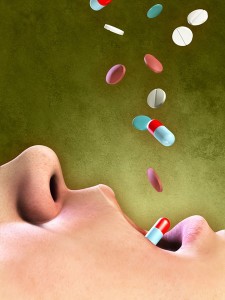
For most of human history, infectious diseases have been the leading causes of illness and death. Most ancient peoples used botanicals as the earliest antibiotics to combat various plagues, even without specific knowledge regarding the microbes responsible. With the advent of modern pharmaceutical techniques, industrialized nations no longer rely on plants for cures, and millions of lives have been saved. However, we have now entered an age where the indiscriminate use of antibiotics in health and the food industries is causing significant harm to all living forms on Earth – and to the planet itself. According to a Princeton Environmental Institute study published in The Lancet, worldwide antibiotic use increased an incredible 36 percent from 2000 to 2010. The United States, sadly but not surprisingly, led the world in antibiotic use per person during this time period. The report also noted the grave consequences of the escalation: rising resistance to many of our most commonly used life-preserving medications.
How profound is the resulting cost? Staggering, both in terms of human health and healthcare costs. One report, “A Brief History of the Antibiotic Era: Lessons Learned and Challenges for the Future,” notes, “The mortality rates due to multidrug-resistant bacterial infections are high. Each year, about 25,000 patients in the EU die from an infection with the selected multidrug-resistant bacteria (ECDC/EMEA Joint Working Group, 2009), and more than 63,000 patients in the United States die every year from hospital-acquired bacterial infections. Estimated economic costs due to infections by multidrug-resistant bacteria in the EU result in extra healthcare costs and productivity losses of at least EUR 1.5 billion each year (ECDC/EMEA Joint Working Group, 2009). The annual additional cost of treating hospital-acquired infections from just six species of antibiotic-resistant bacteria was estimated to be at least $1.3 billion in 1992 dollars ($1.87 billion in 2006 dollars) – more than the annual spending on influenza.” A newly publishedstudy directly links antibiotic abuse in animals with significant pediatric health concerns. The authors warn, “Antimicrobial resistance is considered one of the major threats to the world’s health. The use of antimicrobial agents in agriculture can harm public health, including child health, through the promotion of resistance. Because of the link between antibiotic use in food-producing animals and the occurrence of antibiotic-resistant infections in humans, antibiotic agents should be used in food-producing animals only to treat and control infectious diseases and not to promote growth or to prevent disease routinely.”
In addition to the surge of antibiotic resistant infections, other related health ills are of increasing concern. Children regularly exposed to antibiotics gain weight faster than those never prescribed such medications and are atsignificantly higher risk of obesity later in life. The mechanism is likely through altered metabolism caused by dysbiosis, or the imbalance of microbes in the gastrointestinal tract. Antibiotics destroy not only harmful bugs but also the health-promoting bacteria that help regulate metabolic energy efficiency. This disruption in the microbiome increases our likelihood of developing other metabolic diseases like diabetes and impairs our ability to defend against environmental toxins, thereby increasing risk for a whole host of other diseases like cancer and neurological disorders. And we are not the only victims. As I’ve previously written, the spread of resistant infections has also been tied to massive die-offs in various animal and insect species, in turn threatening the health of our planet and all who reside here.
The good news? Finally, doctors are taking notice. A 2014 Consumer Reports National Research Center poll found that greater than 95 percent of those surveyed are very concerned about antibiotic overuse. Most are actively following CDC-recommended steps to prescribe only when medically necessary, not use broad-spectrum drugs when simpler options will work, and talk to patients about why these medications are not needed for all infections. The CDC is also targeting consumers, in particular, parents who historically ask for and expect antibiotics for self-limited conditions like upper respiratory infections and non-streptococcal sore throats.
While we may be making progress in reducing antibiotic demand and prescribing, we are failing miserably in another industry, one that is responsible for about 80% of antibiotic sales in the U.S. According to a 2014 report by the FDA, “the amount of medically important antibiotics sold to farmers and ranchers for use in animals raised for meat grew by 16 percent from 2009 to 2012.” The meat and poultry industries are now increasingly feeding broad-spectrum antibiotics to healthy animals to not only prevent disease but primarily to promote growth. Ironically, this rampant overuse has been linked to increased transmission of resistant organisms (causing life-threatening infections) to humans eating meat from antibiotic-fed animals. The CDC now actively supports the FDA’s call for “the judicious use of antibiotics that are important in treating humans (and) recommends that such antibiotics should be used in food-producing animals only under veterinary oversight and only to address animal health needs, not to promote growth.” Healthcare professionals are urged to petition food industry organizations responsible for antibiotic misuse to change their practices, citing evidence of human harm. Other strategies to limit antibiotic resistance include reducing or eliminating meat consumption and only purchasing meat and animal products (milk and eggs) that come from animals not exposed to antibiotics.
(originally written for the Deirdre Imus Environmental Health Center)
Leave a Reply
You must be logged in to post a comment.